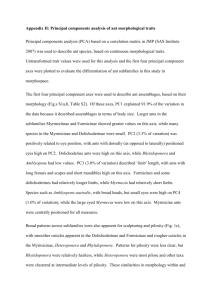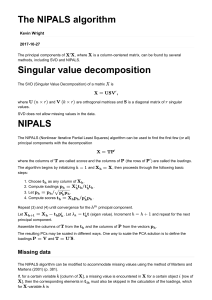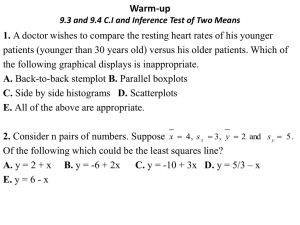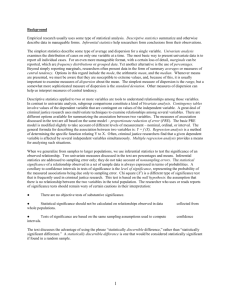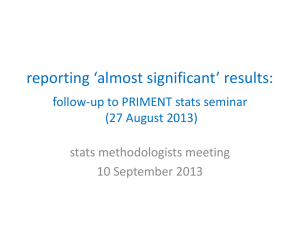A Cautionary Note on Automated Statistical Downscaling Methods
advertisement
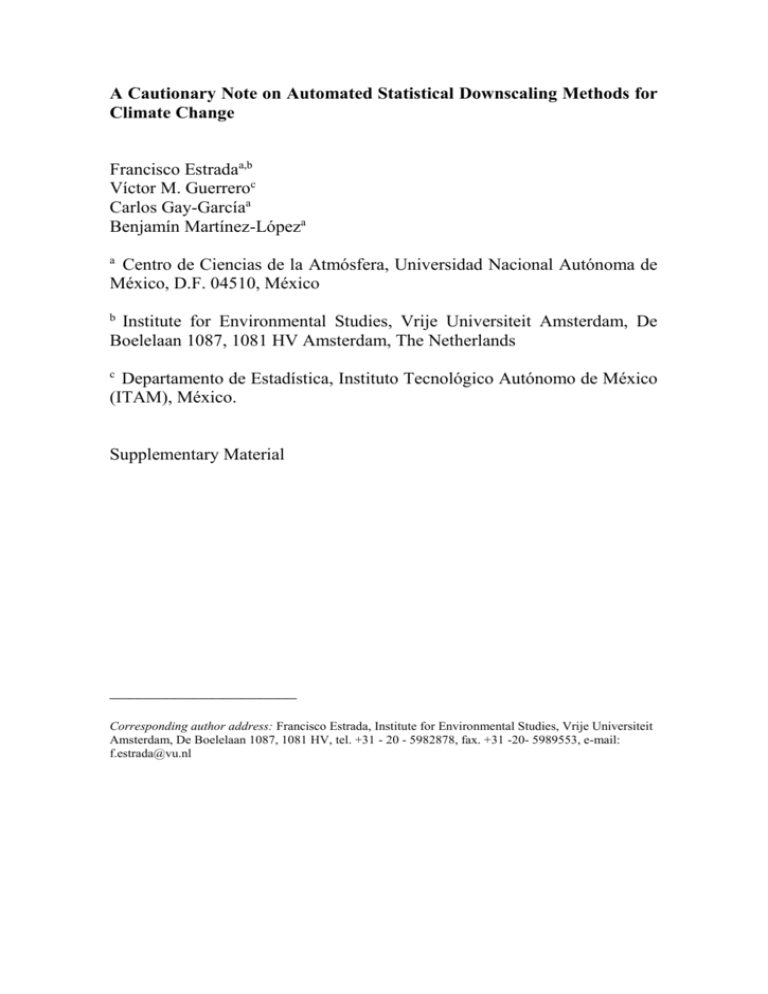
A Cautionary Note on Automated Statistical Downscaling Methods for Climate Change Francisco Estradaa,b Víctor M. Guerreroc Carlos Gay-Garcíaa Benjamín Martínez-Lópeza a Centro de Ciencias de la Atmósfera, Universidad Nacional Autónoma de México, D.F. 04510, México b Institute for Environmental Studies, Vrije Universiteit Amsterdam, De Boelelaan 1087, 1081 HV Amsterdam, The Netherlands c Departamento de Estadística, Instituto Tecnológico Autónomo de México (ITAM), México. Supplementary Material ____________________ Corresponding author address: Francisco Estrada, Institute for Environmental Studies, Vrije Universiteit Amsterdam, De Boelelaan 1087, 1081 HV, tel. +31 - 20 - 5982878, fax. +31 -20- 5989553, e-mail: f.estrada@vu.nl Supplementary Results 1. Principal component analysis of the predictor variables used in Models A, B and C. A principal component analysis was applied to the following large scale atmospheric circulation variables: air temperature at 1000 hPa (T1000), geopotential height at 1000 hPa (GPH1000) and 700 hPa (GPH700). Table SR1 shows the fourteen principal components (PC) for each of these variables, and as can be seen from this table the first five of them account for at least 64% of their total variance, while the individual increments provided by the remaining PC is small (starting around 5% and decreasing very fast). The first five PC are plotted in Figure SR1 panels a to c. Table SR1. Explained variance and cumulative explained variance of the first fourteen principal components of T1000, GPH1000 and GPH700. PC T1000 Cumulative GPH1000 Cumulative GPH700 Cumulative 1 22.65% 22.65% 36.51% 36.51% 30.94% 30.94% 2 16.21% 38.86% 19.59% 56.10% 19.47% 50.41% 3 13.36% 52.22% 9.35% 65.45% 12.46% 62.87% 4 6.82% 59.04% 6.94% 72.39% 7.41% 70.28% 5 4.51% 63.55% 5.18% 77.57% 5.66% 75.94% 6 3.71% 67.26% 4.29% 81.86% 5.45% 81.39% 7 3.49% 70.75% 3.53% 85.39% 5.28% 86.67% 8 2.65% 73.40% 3.26% 88.65% 3.52% 90.19% 9 2.51% 75.91% 1.67% 90.32% 2.08% 92.27% 10 2.16% 78.07% 1.40% 91.72% 1.74% 94.01% 11 1.74% 79.81% 1.11% 92.83% 1.04% 95.05% 12 1.66% 81.47% 1.00% 93.83% 0.70% 95.75% 13 1.29% 82.76% 0.70% 94.53% 0.58% 96.33% 14 1.25% 84.01% 0.64% 95.17% 0.47% 96.80% Figure SR1a. Time plot of the first five PC corresponding to T1000. PC1 PC2 PC3 1.5 2 2 1.0 1 1 0 0 -1 -1 -2 -2 0.5 0.0 -0.5 -1.0 -1.5 -3 50 60 70 80 90 00 -3 50 60 70 PC4 80 90 00 90 00 PC5 2 3 1 2 1 0 0 -1 -1 -2 -2 -3 -3 50 60 70 80 90 00 50 60 70 80 50 60 70 80 90 00 Figure SR1b. Time plot of the first five PC corresponding to GPH1000. PC1 PC2 PC3 1.5 1.5 2.0 1.0 1.0 1.5 1.0 0.5 0.5 0.5 0.0 0.0 0.0 -0.5 -0.5 -1.0 -1.0 -1.5 50 60 70 80 90 00 -0.5 -1.0 -1.5 50 60 70 PC4 80 90 00 90 00 50 60 70 80 90 00 90 00 PC5 1.5 2.0 1.0 1.5 1.0 0.5 0.5 0.0 0.0 -0.5 -0.5 -1.0 -1.0 -1.5 -1.5 50 60 70 80 90 00 50 60 70 80 Figure SR1b. Time plot of the first five PC corresponding to GPH700. PC1 PC2 1.2 0.8 PC3 1.5 1.2 1.0 0.8 0.5 0.4 0.4 0.0 0.0 0.0 -0.5 -0.4 -1.0 -0.8 -1.5 -1.2 -0.4 -0.8 -2.0 50 60 70 80 90 00 -1.6 50 60 70 PC4 80 90 00 90 00 50 60 70 80 PC5 1.6 2 1.2 1 0.8 0.4 0 0.0 -1 -0.4 -0.8 -2 -1.2 -1.6 -3 50 60 70 80 90 00 50 60 70 80 Table SR2. Approximated 95% confidence intervals for the regression coefficients in Models A, B and C. (± 2 standard errors) Model A Total Intercept PC1 PC2 PC3 PC4 PC5 Mean 2.98 0.32 0.76 0.56 0.42 0.44 0.48 Maximum 6.23 0.67 1.59 1.17 0.88 0.92 1.00 Minimum 1.36 0.15 0.35 0.26 0.19 0.20 0.22 Model B Total Intercept PC1 PC2 PC3 PC4 PC5 Mean 4.47 0.38 1.10 0.75 0.83 0.66 0.76 Maximum 8.30 0.70 2.03 1.39 1.54 1.23 1.41 Minimum Mean Maximum Minimum 2.25 0.19 0.55 0.38 0.42 0.33 Model C Total Intercept PC1 PC2 PC3 PC4 4.18 0.38 1.15 0.74 0.83 0.52 7.82 0.71 2.15 1.38 1.55 0.97 1.77 0.16 0.49 0.31 0.35 0.22 0.38 PC5 0.57 1.07 0.24 Note: Total represents the sum of the individual coefficients intervals. 2. Maps of the coefficients, t-statistics and misspecification tests for Models A, B and C. Figure SR2a. Significance of individual misspecification tests applied to Model A. Note: Areas in green denote statistical significance at the 5% level. The Breusch-Godfrey, Ljung-Box (Q-statistic), McLeod-Li, ARCH tests were conducted including from one to four lags, the BDS test considers a correlation dimension of four points. The White test does not include the cross-products. For the Quandt-Andrews test a 20% trimming was chosen. Figure SR2b. Slope coefficient values (upper panel) and their statistical significance at the 5% level (lower panel) for Model A. PC1 PC2 PC3 PC4 PC5 Note: Areas in green denote statistical significance at the 5% level. Figure SR3a. Significance of individual misspecification tests applied to Model B. Note: Areas in green denote statistical significance at the 5% level. The Breusch-Godfrey, Ljung-Box (Q-statistic), McLeod-Li, ARCH tests were conducted including from one to four lags, the BDS test considers a correlation dimension of four points. The White test does not include the cross-products. For the Quandt-Andrews test a 20% trimming was chosen. Figure SR3b. Slope coefficient values (upper panel) and their statistical significance at the 5% level (lower panel) for Model B. PC1 PC2 PC3 PC4 PC5 Note: Areas in green denote statistical significance at the 5% level. Figure SR4a. Significance of individual misspecification tests applied to Model C. Note: Areas in green denote statistical significance at the 5% level. The Breusch-Godfrey, Ljung-Box (Q-statistic), McLeod-Li, ARCH tests were conducted including from one to four lags, the BDS test considers a correlation dimension of four points. The White test does not include the cross-products. For the Quandt-Andrews test a 20% trimming was chosen. Figure SR4b. Slope coefficient values (upper panel) and their statistical significance at the 5% level (lower panel) for Model C. PC1 PC2 PC3 PC4 PC5 Note: Areas in green denote statistical significance at the 5% level. Figure SR5. Significance of multivariate misspecification tests applied to Model A. Note: Areas in green denote statistical significance at the 5% level. Figure SR6. Significance of multivariate misspecification tests applied to Model B. Note: Areas in green denote statistical significance at the 5% level. Figure SR7. Significance of multivariate misspecification tests applied to Model C. Note: Areas in green denote statistical significance at the 5% level. 3. Misspecification results for the respecified version of Model B. Table SR3. Percentage of misspecified regressions using univariate tests. MS JB AD BG LB W ML ARCH BDS RESET QA Model A 71.78% Model C 54.24% 4.01% 6.72% 25.26% 18.95% 4.31% 9.87% 8.82% 29.17% 5.41% 27.62% 5.26% 7.42% 9.02% 6.97% 2.61% 5.26% 4.56% 27.77% 1.70% 16.44% Note: All abbreviations are defined as in Table 2 of the main text. Figure SR8a. Significance of individual misspecification tests applied to Model B (respecified). Note: Areas in green denote statistical significance at the 5% level. The Breusch-Godfrey, Ljung-Box (Q-statistic), McLeod-Li, ARCH tests were conducted including from one to four lags, the BDS test considers a correlation dimension of four points. The White test does not include the cross-products. For the Quandt-Andrews test a 20% trimming was chosen. Figure SR8b. Slope coefficient values (first and third panels) and their statistical significance at the 5% level (second and fourth panels) for Model B (respecified). PC1 PC2 PC3 PC4 PC5 (PC1)^2 PC4(-1) Note: Areas in green denote statistical significance at the 5% level. PC5(-1) Linear trend Quadratic trend


